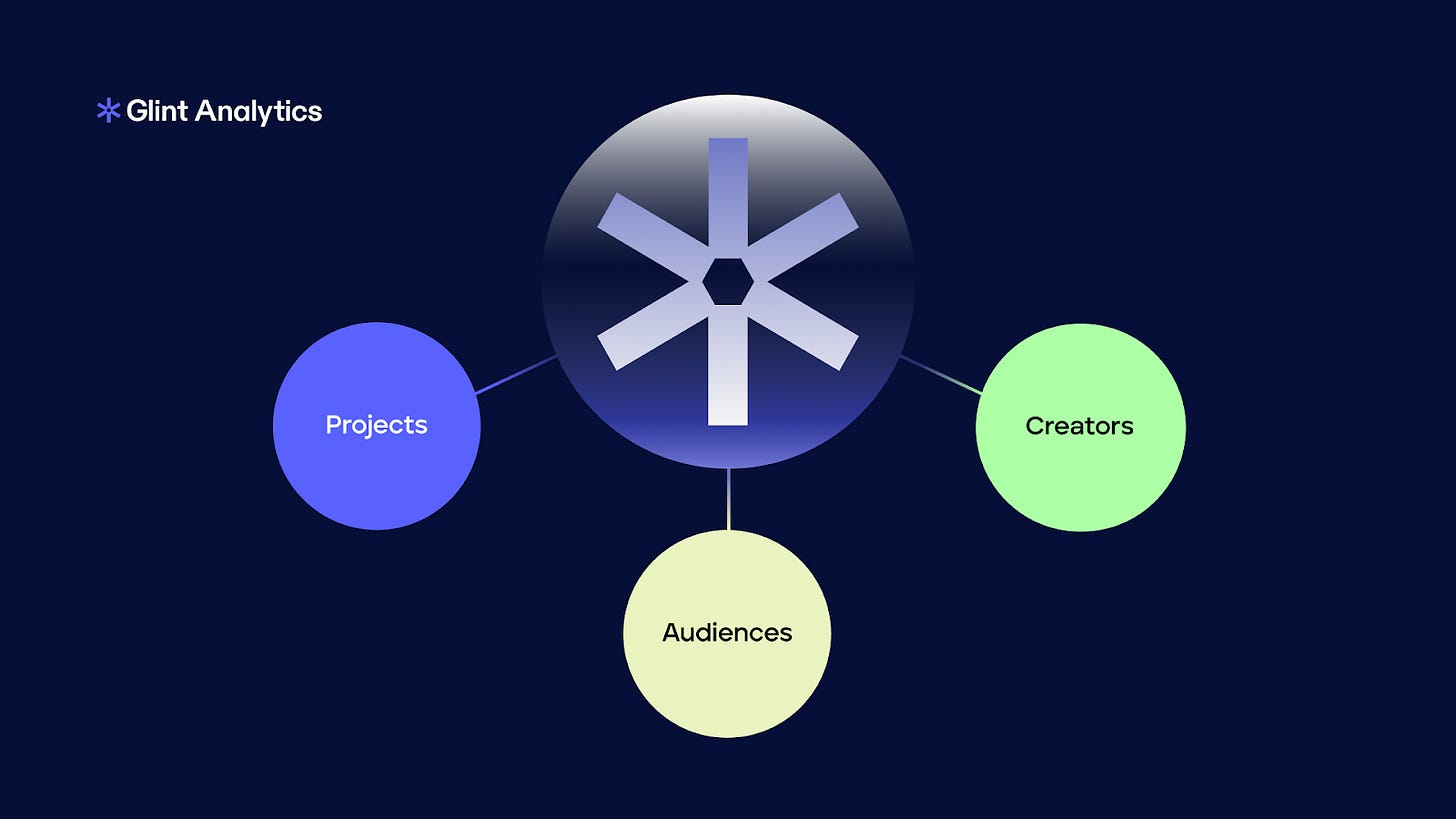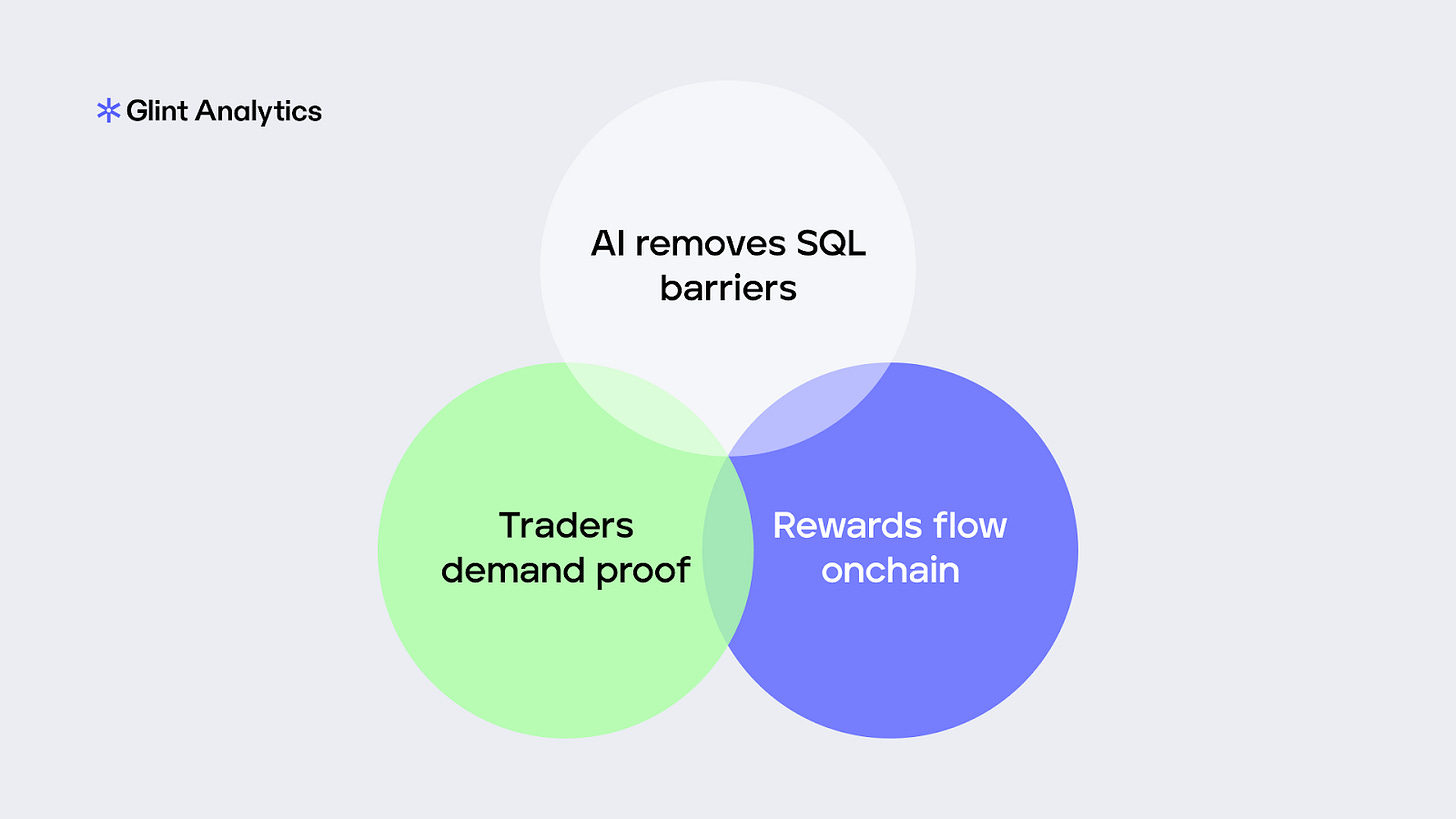The Future of InfoFi: Building the Analyst Economy
Have you ever seen a tweet with a chart that just clicked?
Maybe it was a chart showing whale accumulation patterns before a price move. Or a breakdown of protocol revenue that made you realize everyone was valuing it wrong. Or a simple visualization that revealed a trend hidden in plain sight.
That moment when data becomes insight, when you see something clearly for the first time and know exactly what it means, we call that a Glint.
We’ve all experienced it. A well-constructed chart that makes complexity simple. A data visualization that surfaces a pattern you’d been missing. An analysis that connects dots you hadn’t considered.
These insights change how we see markets. They inform trades. They shape investment decisions. They help us understand what’s actually happening beneath the noise.
But here’s the problem: the people who create these Glints rarely capture the value they generate.
InfoFi’s Missing Layer
InfoFi showed crypto something important: you can build economies around information and content creation. Projects pay creators. Creators produce content. Audiences consume it. Value flows.
But InfoFi built an awareness economy, not an intelligence economy.
The content it incentivized was promotional. Projects paid for coverage, creators delivered what sponsors wanted, and audiences learned to discount most of it. InfoFi proved the economic model works, but it optimized for reach over substance, engagement over accuracy, virality over verifiability.
What made 2025’s InfoFi wave unsustainable wasn’t the concept. It was what got rewarded: awareness without data underneath. Hype without verification. Takes without analysis.
When traders searched for actual intelligence about protocols, they found promotional content. When they needed data to evaluate fundamentals, they got narratives. InfoFi created buzz but left them with no way to separate signal from noise.
The economic model was right. The incentive structure was wrong.
InfoFi With Data Backing
The analyst economy is InfoFi rebuilt around substance instead of promotion.
Same core concept: reward people for creating valuable content about blockchain projects. Different foundation: that content must be backed by verifiable data.
When your Glint creates value for others, you capture some of that value. When an insight proves useful to traders, projects, or investors, the analyst who created it earns rewards. Just like InfoFi, but with one critical difference: quality is determined by usefulness, not sponsorship.
No permission needed. No credibility compromises. Just a direct economic relationship between the creation of data-backed intelligence and the value it generates.
This is what Glint Analytics is building. Analysts create dashboards analyzing any protocol they choose using AI-powered tools. Technical barriers disappear. You can build sophisticated analysis using natural language, no SQL required. What used to take days now takes minutes.
When traders find these insights valuable (engaging with them, sharing them, acting on them), the original analyst earns rewards through the $GLNT token. The more useful the insight, the more it spreads, the more the creator earns.
Projects get authentic, data-driven coverage without paying for promotional content. Analysts earn from their expertise without selling their credibility. Traders find intelligence they can verify and trust.
It’s InfoFi’s economic model applied to intelligence instead of awareness.
What Makes a Glint
Not every chart is a Glint. Not every analysis deserves rewards.
InfoFi taught us that incentivizing content creation is easy. Incentivizing quality content is hard. The analyst economy solves this through three characteristics that separate signal from noise:
Data-backed: Every claim traces to verifiable onchain data. No “trust me bro”, no unnamed sources, no confusing correlation with causation. Show your work or it’s not a Glint. This is what InfoFi was missing.
Actionable: The insight matters for decision-making. Whether you’re trading, building, or investing, a Glint gives you information you can use. Interesting observations aren’t enough. Glints change how you think about a position.
Market-validated: Usage determines quality. Glints that prove useful get shared, acted on, and rewarded. Those that don’t fade. No committees decide what’s valuable. No badges verify credibility. The market filters quality naturally.
This last point is what makes it sustainable. InfoFi struggled because sponsored content looked like what it was: paid promotion. The analyst economy works because rewards follow genuine usefulness, not payment for coverage.
Quality rises naturally when the market determines value instead of sponsors.
Why Now
InfoFi proved the model works. Three shifts make the data-backed version possible in 2026.
First, AI eliminated the technical barrier. InfoFi was accessible to content creators but not analysts. Creating blockchain analysis required SQL expertise, understanding complex data schemas, and hours of manual work. Most potential participants were locked out. Now anyone with analytical insight can create professional dashboards using natural language. The barrier between “I see something interesting” and “I can prove it with data” has collapsed.
Second, audiences learned to spot promotional content. InfoFi’s paid thread economy collapsed because traders got good at identifying sponsored content and discounting it. What they’re hungry for now is analysis they can verify. Data they can check themselves and conclusions they can challenge. The market is ready for InfoFi’s economic model applied to substance instead of hype.
Third, the infrastructure finally exists. Building an analyst economy requires platforms that connect analysts with audiences, reward mechanisms that distribute value fairly, and technical tools that make participation accessible. That infrastructure is now live through Glint Analytics, powered by the $GLNT token.
InfoFi showed the path. The analyst economy is what happens when you build it right.
The Intelligence Gap
InfoFi created more content. The analyst economy creates better intelligence.
Crypto is drowning in threads, newsletters, alpha calls, commentary. Most of it is narrative without data. Hype without verification. Takes without analysis. The signal-to-noise ratio keeps getting worse because creating content is easy and creating intelligence is hard.
Meanwhile, blockchain data sits unused. Protocols generate millions of data points daily. Most never get analyzed. The few analysts capable of extracting genuine insights focus on established projects because there’s no economic model for covering emerging protocols.
Good projects with strong fundamentals stay invisible because no one has incentive to analyze them. Traders miss opportunities because the analytical work hasn’t been done. Markets stay inefficient because intelligence doesn’t flow to where it’s needed.
The analyst economy solves what InfoFi couldn’t: making quality intelligence creation economically sustainable. When data-backed analysis gets rewarded, more gets created. When analysts can earn from their expertise, they cover more projects. When Glints spread based on usefulness rather than sponsorship, markets get smarter.
How It Works
The analyst economy is live. Here’s what it looks like in practice:
For Analysts: Create insights about projects you find interesting. Share them openly. Earn rewards when they prove valuable. Build a sustainable business around your expertise, not your follower count. Unlike InfoFi’s sponsorship model, the analyst economy rewards quality work directly based on market validation.
For Projects: Make your data accessible and let analysts discover what’s interesting about your protocol. If your fundamentals are strong, they’ll find them. Authentic coverage from independent analysts beats the promotional content that defined InfoFi and taught audiences to be skeptical.
For Traders: Demand insights you can verify. Follow analysts who show their work. When you find valuable intelligence, engage with it. Your attention rewards the people doing real analysis and strengthens the economic model. Unlike InfoFi where engagement often rewarded hype, here it rewards substance.
For the Ecosystem: Intelligence flows freely and analysts capture the value they create. Data becomes accessible. Quality gets rewarded based on usefulness, not sponsorship dollars. The people extracting signal from noise build sustainable businesses around that skill.
What Changes
InfoFi showed that content economies work in crypto. The analyst economy shows what happens when you optimize for substance instead of reach.
Good projects get discovered faster because analysts have economic incentive to find them, not just cover what sponsors pay for. Bad projects get exposed sooner because faking fundamentals doesn’t work when people check the data. Traders make better decisions because they’re acting on verifiable Glints instead of promotional content.
Noise drops. Signal strengthens. Intelligence becomes the competitive advantage it should be.
This isn’t about replacing InfoFi’s lessons about content economics. It’s about applying those lessons to intelligence instead of awareness. Systematic rewards for analytical work that creates real value, determined by the market instead of sponsorship deals.
Over time, the best analysts build sustainable businesses. Projects get visibility based on fundamentals. Traders access intelligence they can trust. The ecosystem gets more efficient.
The analyst economy grows because it fixes what InfoFi got wrong while keeping what it got right.
2026: InfoFi Grows Up
InfoFi proved crypto will pay for content about projects. The analyst economy proves crypto will pay more for content backed by data.
Where insights replace narratives. Where analysts capture value based on usefulness, not sponsorship. Where markets get smarter because intelligence flows freely and gets rewarded fairly.
The infrastructure is live. The $GLNT token powers the rewards network. Analysts are creating dashboards and earning from their insights right now.
InfoFi built the model. The analyst economy perfected it.
The premise is simple: if your Glint creates value for others, you should capture some of that value.
Everything else follows from there.
Get early access to the $GLNT token sale at CoinTerminal.
Learn more at glintanalytics.com or follow @GlintAnalytics on Twitter.






